Stay in the know on all smart updates of your favorite topics.
People get more connected and technology becomes part of our daily life. Between 2014 and 2015 there was a 27% growth of internet traffic in Amsterdam. Eleven out of fifteen Trans-Atlantic data cables are connected with or go through Amsterdam and the AMS-IX is the second largest internet exchange point in the world. In 2016 Amsterdam was ranked second in the European Digital City Index. Do you work on a smarter city? Share your technologies here!
Op weg naar een flexibel, robuust en betaalbaar energiesysteem
In mei van dit jaar trad Ingrid Thijssen, CEO van Alliander, toe tot de Board. Als één van de grootste energienetwerkbedrijven van Nederland, voelt Alliander een grote maatschappelijke verantwoordelijkheid. Daaraan geeft het bedrijf onder meer invulling door actief bij te dragen aan de ambities van de Board. “Door slim samen te werken, vooruit te kijken en slim gebruik te maken van de openbare ruimte, maken we de regio samen klaar voor de toekomst.”
The pitfalls of city data strategies
🤔 Is data really the new oil? Do you need big data to tackle an urban challenge? Are you sure?
Cities increasingly realise that defining a data strategy is a journey full of pitfalls and challenges.
Doughnut cities
This is the title of the newest edition in my series 'Looking for the humane city'. The well-known Kate Raworth plays an important role, but I refer to other approaches too.
Wie het artikel liever in het Nederlands leest han hier terecht: https://wp.me/p32hqY-1OE
How Amsterdam is learning from Uber's aggregate data
In July Amsterdam signed a ‘social charter’ with ride-hailing operator Uber, following a series of high-profile accidents involving its drivers in the Dutch capital last winter.
This, and more, was discussed at the City Leadership Forum in Vienna.
Green IT Barometer 2019

In partnership with Green IT Amsterdam (NL), Sustainability For London (UK), Green IT Belgium (BE), Green IT SIG (CH) and FISMA (FI), Alliance Green IT (FR) launched the survey for the 3rd edition of the Green IT Barometer.
This survey aims to assess the number of computers and office equipment present in companies and more generally the maturity of companies in the use of eco-responsible digital services.
This is the third edition of this survey called Green IT Barometer.
The first two editions, 2015 and 2017, have been the subject of two publications: http://alliancegreenit.org/publications (in French only)
Answering this survey will allow you to
- Know the best practices, thanks to the game of questions
- Measure your level of maturity
- Compare your results
From October 1st, 2019 to January 31st, 2020, all companies can answer in an entirely anonymous way the online questionnaire on:
>> https://www.surveymonkey.com/r/greenitbarometer2019 > In April 2020, the results will be published, in a strictly anonymous way.
Bestel het boek ‘Een slimme stad, zo doe je dat’
Dit jaar onderzoekt de Future City Foundation met 26 partners hoe we de smart city moeten ontwerpen. We denken dat de stedenbouw en de producten die daaruit voortkomen radicaal veranderen. Net zoals dat gebeurde met andere bedrijfstakken. We willen begrijpen hoe dat gebeurt, welke kansen dat oplevert en welke risico’s er aan kleven.
De resultaten van het project presenteren we in een boek – genaamd ‘Een slimme stad, zo doe je dat – Verbonden, flexibel en betekenisvol; maak de echte future city’. U kunt het boek (met ruim 200 pagina’s) aanvragen via het aanvraagformulier. Digitaal lezen is gratis, voor een gedrukte versie vragen we €29,-.
Bestel het boek via https://future-city.nl/bestel-het-boek-een-slimme-stad-zo-doe-je-dat/
Operating System for a City

Have you ever thought about your city as a computer, and about institutions and administration as an OS operating system for it? This metaphor is becoming more and more relevant to reality. Telephones are turning into smartphones and cities into smart cities.
The new system for cities is being downloaded ...
Read full article: http://smartcitiespolska.org/en/new-operating-system-for-smart-cities/
According to statistics, you use a smartphone to read this page. Do you know what is the most important and most valuable component of it besides the camera? Of course its operating system. This single element can increase the power and safety of the device.
If it works inefficiently, you risk losing data, slowing down performance, and quickly draining of the battery. Current city's operating systems have many disadvantages. We know this feeling of system malfunction well.
If operating system performs its function in the background, we can experience games and multimedia on the screen and use our software necessary for a business. The same rule applies to cities and it's "operating systems".
Read more:
https://www.linkedin.com/pulse/operating-system-city-mateusz-jarosiewicz/
‘Urgency creates opportunities’ – recap of the Amsterdam Smart City event ‘Het Net Onder Spanning’
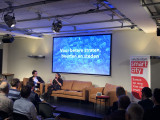
The changes in the field of sustainability are in full swing. Electric cars, heat pumps and solar panels ensure that a lot of people can make their contribution, even at home. At the same time, these innovations appeal to the electricity grid in the city. More infrastructure is needed to be able to supply the increasing demand for electricity. On the other hand, we have to deal with electricity in different ways. How do we do this? What is needed to keep moving forward? And how do we involve residents in this?
On the 15th of October, Amsterdam Smart City and some of our partners discussed this topic in Pakhuis de Zwijger. Amsterdam Smart City aims for a conversation between its partners and the general public. After all, residents are the ones that have to deal with all innovative projects and the ones with great initiatives themselves, so let’s involve them as soon as possible!
This summer, grid operator Liander and the City of Amsterdam launched a report with an alarming message: in 2050 we will need 2,5 times more electricity than we do now. Eric Koldenhof from the Sustainability department of the City of Amsterdam and Paul van Engelen, region lead Amsterdam of Liander told the audience that this is quite a puzzle, with a growing population and shrinking physical space. For Amsterdam this expected increase in electricity demand means we will need 6 to 8 more electrical substations and around 2.500 small containers throughout the city. They showed a map with warning signs: some of the current substations are already reaching their maximum capacity.

Leonie van den Beuken, program director of Amsterdam Smart City, asked Koldenhof and Van Engelen how critical this issue really is: ‘Is there a possibility we will not be able to switch on a light in the near future?’ Paul: ‘We won’t lose power, don’t worry. The real problems are the new developments. With the current capacity on the grid, it will be very hard to connect new customers, such as big car charging stations or datacenters.’
We will need to expand the electricity grid, but there are two other big recommendations in the research: we need innovative solutions that can work off the grid or efficiently to reduce the impact on the grid and the City and Liander want to look forward and cooperate more. If we have to open up a street for cabling, this can be a possibility to do other constructions simultaneously.
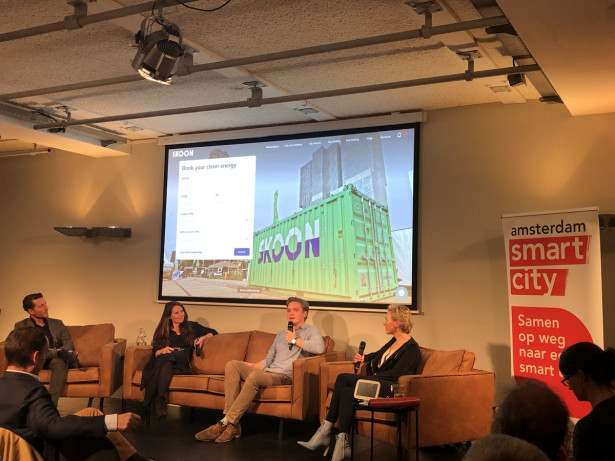
Falco Pieters from Stichting Wiek-II, Peter Paul van Voorst from Skoon Energy and Marjolein Bot from the Amsterdam Economic Board are the ones with solutions to unburden the electricity grid. In Arnhem-Nijmegen, Falco combines technological innovations, wind and solar energy with the participation of citizens. Wiek-II found a way to connect this generated energy to the grid more efficiently and they are happy to copy the concept to other areas in the Netherlands.
Skoon Energy created big switch batteries, mainly for the maritime sector, but they also work for festivals and construction – and perhaps even in the city as a temporarily solution These batteries are short term solutions, but batteries can be charged when there is space on the grid. Peter Paul: ‘I am really happy with the ambitions of the City of Amsterdam and the urgency for innovation. This creates opportunities for my business!’
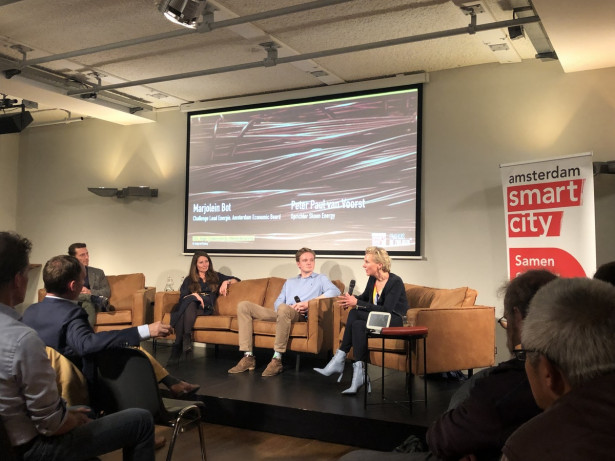
Marjolein Bot told the audience about her research on the influence of digitalization. Not only sustainable solutions ask for more electricity, data and digitalization are increasing the demand as well. Marjolein is working on efficiency in IT such as green coding, photonics, blockchain, AI and datacenters.
In 2021 governments with plans for the public space will be obliged to incorporate citizens’ opinions in their plans (‘Omgevingswet’). This means that participation and co-creation with citizens is becoming more important, also in the decision on where to build new electrical substations in the city. How can we make sure that participation is useful and meaningful? Dave van Loon (Kennisland), Melika Levelt (Amsterdam University of Applied Sciences) and Pauline Westendorp (02025) are working on participation on a day-to-day basis.
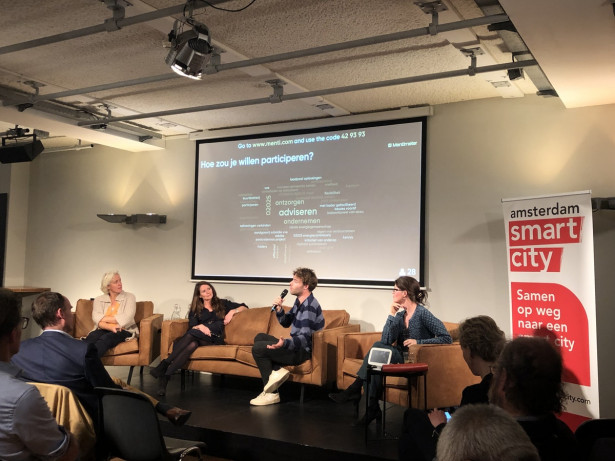
The panel discussed the conditions for citizens to participate in these kind of processes. Melika Levelt: ‘As a government or company, please be clear about the processes that are fixed and that are going to happen anyway. Be clear about the influence residents can have and tell them honestly if you have to make another choice because of political reasons. Citizens will only be interested if you have clear and concrete questions. Take time to hear as many opinions as possible. They really have a feeling about the physical space and their neighbourhood, so take this into account. It is not only a project, but really a place to live.’ Dave: ‘And it is very important to realize that a lot of individuals won’t take the time to cooperate with you. You have to get in touch with citizens’ initiatives and local cooperatives.’

Paulien challenged the City of Amsterdam: ‘Can we focus on developments before 2030 or 2050? Can we make changes now or tomorrow? People are ready for it!’ But be aware: not everyone wants to participate. Some people just want others to take the lead in these developments. And that’s fine as well.
Watch the live feed of the evening here: <https://dezwijger.nl/programma/het-net-onder-spanning>
Want to know more about this? Visit the Kennisland event ‘Out of Office #29: ‘Eerlijke en inclusieve energietransitie: snel en toch samen?’ about the honest and fair energy transition. (in Dutch) Thursday 31 of October in Amsterdam!
Solutions for the nitrogen emissions crisis
The nitrogen emissions crisis has seen as many as 18,000 construction and infrastructure projects stall across the Netherlands, and hundreds of farmers protesting in their tractors. But nitrogen impacts represent one of the greatest threats to our planetary life support systems, with big consequences for biodiversity and climate change.
So, why are nitrogen emissions a problem in the first place? Is the issue primarily related to construction, farming, or something else, and how do we fix this?
Our Industries team lead Pieter van Exter undertook some detailed analysis and outlines potential pathways out of the crisis.
Dutch cities slam central government’s 5G proposals
Seven Dutch cities are fighting against a central government proposal that would give free rein to telco providers over the installation of 5G antennas.
Amsterdam, Rotterdam, The Hague, Utrecht, Eindhoven, Groningen, and Almere, backed by the Dutch Association of Cities, say that the proposed bill would force them to provide telcos with full access to public assets.
Royal Haskoning signs Tada

We’re thrilled to have Royal Haskoning RHDV as a signatory of the Tada (https://tada.city/) movement in #Amsterdam.
"We know that the promise of using data can be huge – and this ties in closely in our collaboration with City of Amsterdam to optimise peopleflows in the city centre," says Frank Legter (Director Business Unit Transport & Planning Europe) "But we must ensure that we collect data correctly and enable people to stay in control of their data so that we create responsible digital cities."
Pre-order book: A smart city, this is how you do it
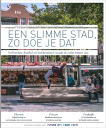
Connected, flexible and meaningful: make the real future city
If the whole world changes as a result of the rise of internet technology and digitization, how will urban planning, planning and spatial planning change? What are the new starting points? And how should directors, designers, organizers and managers get to work on this? The Future City Foundation, started working with those questions, together with 26 partners, in the past year. In the book 'A smart city, this is how you do it - Connected, flexible and meaningful: make the real future city' you can read the result.
The first question we have asked ourselves is what kind of city we want. When we are in a transition, it is good to set the limits. We put it on two levels. First, we want a city that meets the requirements of sustainable development goal 11: inclusive, safe, healthy and sustainable. But we also want us to be able to live there in freedom.
Then we asked the question of how digitization and technology affect our regions, cities and villages. We conclude that connectedness is the real game changer. We are always connected to everything and everyone. Everything becomes a smart and democratic network. This network makes us very flexible. We can do everything anywhere.
Finally, we asked ourselves where we want to be. We seek meaning. That makes the profession of the designer more important than ever. Even if we can be everywhere, we are only in one place. Then of course we choose the place where we prefer to be. But how do you design that place? And in addition: how do we prevent ourselves from being over-stimulated? Here perhaps lies the core. Because smart urbanism is not about smart, not about technology. But about the consequences. About how society is changing. The role that citizens, businesses and governments have also shifts from one another. We hope this leads to more citizenship. To more influence of people on their living environment.
You read it in the book “A smart city, this is how you do it - Connected, flexible and meaningful: make the real future city,” published on October 28, 2019. With theory in essays and interviews with inspiring precursors. 26 tutorials with step-by-step instructions and other process tools to comprehend the theory. And 15 practical examples, in which you learn how our regions, cities and villages have already changed. This book is a publication of the Future City Foundation in collaboration with BNSP, NVTL and 24 other partners.
The book is in Dutch. Mid november the English version is published.
Order the book via https://future-city.nl/smartstedenbouw. Digital reading is free, for a printed version we charge € 29.
Energietransitie slaagt alleen als iedereen mee kan doen
Op naar een meer sociaal-inclusieve energietransitie in en vernieuwing van de wijk!
Deal between Yandex.Taxi and “Vezyot”, 5G testing and appointments in telecom

It is highly unlikely that Yandex.Taxi will purchase the assets of “Vezyot” GC , as planned before. In response to the taxi aggregator Gett’s complaint, the Federal Anti-Monopoly Service might not allow to conclude a deal in some regions of Russia, where it can have a negative impact on competition. In this case the the Service will order shareholders not to sell assets or sell them to another competitor. Alfa-Bank analysts consider that Mail.ru Group’s “Citymobil” is the most probable competitor to buy the assets of “Vezyot” in the regions.
In July Yandex claimed it planned to buy the software and call-centers of “Vezyot” GC and therefore submitted an application to the Federal Anti-Monopoly Service. Mail.ru Group claimed that the parties had to obtain a written permit for asset purchasing from Mail.ru Group, which gave a convertible loan to “Vezyot” in 2018. In return “Vezyot” replied they had not broken lending laws.
Yandex.Taxi IPO launch was planned for 2019 or 2020. According to a recent evaluation, the service costs $7.7–8.5 billion, while the whole Yandex’s capitalization costs $12.4 billion.
In Moscow Yandex.Taxi’s (together with Uber) taxi aggregator market share is over 68%, and “Vezyot” only has 2% of shares. At the same time across Russia Yandex.Taxi has about 47% of shares, while “Vezyot” has 24%. in Moscow Gett got 5.7% market shares and in the whole Russian market it got 9.7%.
According to Discovery Research Group, the Russian taxi aggregator market’s monetary value was estimated at 290.5 billion rubles in 2018 (146.8 billion in the previous year). Analysts note that aggregators put conventional taxi companies under the control of IT companies.
Telecom news
• Beeline launched a 5G pilot testbed in “Luzhniki” and broadcasted it via social networks. The operator claimed during testing they recorded 3.3 Gbps speed per one Huawei device.
• MTS in turn tested Solutions for smart transport in the pilot area in VDNH and presented 3 5G use case scenarios to increase on road safety — “Smart overtaking”, “Smart crossroad” and “Safe pedestrian”.
• First official news about the anticipated reorganizing of the Moscow broadband internet service provide leader, MGTS, came out. From September 16, its Director General Pavel Kuznetsov also holds the position of the MTS Moscow region Director, previously held by Igor Egorov. Previously the news about MGTS reorganization was reported by “Kommersant”. The information about new appointments in top management is stated in the operator’s documents, though MTS had not commented on it yet.
• Moreover, this week MTS launched a ticket selling platform “MTS Afisha” and plans to open “MTS Live Arena” concert venue for up to 11.5 thousand people. It Will be located near “Skolkovo” innovation center.
• Vitaliy Klishin was appointed Director of the Moscow branch of “ER-Telecom”. He previously held the position of Vice President of “AMT-Group” and worked for “Volga Telecom” and “AKADO”. He will start modernizing the network and increasing revenues, including B2B segment, which the company has been working in since last autumn.
• Tele2 obtained the permission to continue eSIM testing from the Ministry of Communications. The Ministry stated that the operator fixed all eSIM security issues and the test algorithm full supports subscriber identification. Up to 15 thousand subscribers will participate in the testing.
Retail for online
Experts note that one of the trends in telecom retail is the openness of the infrastructure for partners within the concept of digital services department store. Last week two pieces of news were dedicated to the examples of such cooperation.
MTS in its phone stores will offer clients to install a set of apps with Yandex services (Yandex.Browser, Yandex.Taxi, Yandex.Drive and Auto.ru)on their smartphones. The internet company’s apps will be available in other retail stores.
Megafon in its phone stores allowed users to verify their identity in Yandex.Money. This option is also available in “Svyaznoy”, “Euroset” stores and “Unistream” offices.
Russian Telecom Giant & China’s Huawei Launch 5G Zone in Moscow

Russian mobile operator MTS has launched a 5G zone at VDNKh (All-Russian Exhibition Center), one of Moscow’s major attractions. Equipped by Huawei and functioning on the 28GHz and 4.9GHz frequency bands, the network became operational on Thursday. It will test so-called Smart City technology, designed to improve security and urban services management, as well as helping to develop Moscow’s transport system.
The agreement between MTS and Huawei was signed in June during the St. Petersburg International Economic Forum.
5G is speeding up the development of self-driving vehicles in Moscow together with other future technologies, according to Eduard Lysenko, Head of the city’s Department of Information Technology: “Moscow is looking into the implementation of telemedicine and IoT technologies in city services which require a secure and fast connection”.
While the super-fast network is currently available around only one of the pavilions in the VDNKh complex, the pilot zone is expected to expand and cover almost the whole of the VDNKh area by 2020.
Owners of 5G-capable smartphones will be able to enjoy super-fast internet connections after the network’s commercial launch, as the first phone connected to the network demonstrated an internet speed of 1.2Gbps. This means it will take around one minute to download a full HD movie.
Moscow’s first 5G zone was launched earlier this month and covers the famous Tverskaya Street. Swedish telecom company Ericsson provided the equipment for the network, which is run by Russian mobile operator Tele2. By the end of this year, Moscow is expected to have four pilot zones, each operated by one of Russia’s four major telecom providers.
Denk mee: Opzet NL programma Digitalisering Openbare Ruimte
Op 24 september is er een werksessie, tijdens de Common Ground week van VNG, waarin onderzocht wordt welk bovenstedelijk programma nodig is om de 'slimme stad' pilots en projecten op te schalen, naar grote icoonprojecten voor Nederland.
De openbare ruimte wordt steeds verder gedigitaliseerd. Sensornetwerken slinger zich door de stad, we willen schonere lucht, betere doorstroming van het verkeer, bestand tegen hoosbuien en hitte. Er komen ook grote veranderingen aan die de stad letterlijk op de schop nemen: de grond moet open voor gasbuizen, stroomvoorziening, riolen, glasvezel. Werkelijk unieke kansen om de stad te digitaliseren.
Denk en doe mee tijdens dit PI event.
Locatie: Catharijnesingel 55 Utrecht, op loopafstand van CS Utrecht
Dag en tijd: 24 september van 9:00-14:00 (inclusief lunch)
Aanmelden: via email naar h.nouwens@connectedworlds.nl
Hoe kan Noord-Holland het beste met data omgaan?
De provincie Noord-Holland en andere provincies experimenteren volop met de inzet van data, algoritmen en nieuwe technologie. Hoe worden burgers en maatschappelijke organisaties erbij betrokken? Daarover gaat dit onderzoek van het Rathenau Instituut:
The disinformation age: a revolution in propaganda
“More information was supposed to mean a more informed debate, but we seem less capable of deliberation than ever.”
The negative side of the (via the internet) connected society. When you think a bit further about the possibilities that smart city concepts offer, you should not leave this aspect unmentioned. But where do we start amd where does it end ……
SMART-CITY: Defined by insiders.
A Smart-City can be defined as the achievement of maximum quality of life with a minimum use of resources, with the help of the intelligent networking of digital technologies. It is possible to make a city more attractive, more environment-friendly and less wasteful of energy or water, facing several challenges at the same time: social, methodological, technical, organizational and conceptual.
Even if this contemporary utopia for our future cities sounds good, it can be useful to bring in mind that Smart-City and democracy were not primarily related. We are collectively running, worldwide, into this model of living but who asked for it? Mainly IT companies whom business models are based on data exploitation, and governments that sighted a good opportunity to bring private investments in public facilities.
When Artificial Intelligence continues to inspire a lot of innovation debates, we already know that an intelligent decision-making algorithm based on data analysis, would probably not make the same choices than humans, influenced be sensitiveness and natural moral law. What we are living actually is an unprecedented opportunity to up-grade the global efficiency of our urban areas, and implicating all stakeholders in its achievement is the crucial condition to avoid a disastrous bouncing effect against technology in a few decades.
Smart cities are decades away: but open cities are within reach
At the ODI we are working on a project on Open Cities. We have just published a blog about why thinking about open cities, rather than smart cities, can lead to a better future. Interest to see what you all think.
Stay up to date
Get notified about new updates, opportunities or events that match your interests.

